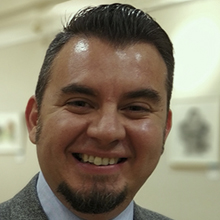La caricatura es una disciplina en sí misma que ocupa un lugar de privilegio en la Historia del Arte
El invitado de hoy a “dialocar conmigo es alguien de fecunda y exitosa trayectoria. Se trata de David Pablo Pugliese, humorista gráfico argentino, radicado en España.
Colabora con sus obras en inumerables publicaiones internacionales, sus caricaturas han sido expuestas en muchísimos países. Ha publicado libros y ha recibido premios y distinciones en la XX Bienal de San Antonio de los Baños, Cuba; en el Primer Festival Internacional de Humor Gráfico del Club Atlético River Plate; en el festival internacional de caricatura "Humour a Gallarate",Italia, en el "Salón Internacional de Humor Gráfico de Pernambuco", Brasil; en el concurso internacional de humor gráfico "Noticartún", Colombia y en en el World Press Cartoon, Portugal.
Pero mejor pasemos ya al “diáloco”…
PP: Amigo mío, te doy la bienvenida, agradeciéndote tu generosidad al aceptar compartir un rato conmigo. Sabes que admiro mucho tu obra (la caricatura de Stan Laurel es la que más me gusta, te lo confieso). Ya va siendo hora que nos
conversemos un café o un vinito frente a frente, ¿no es cierto?
PUGLIESE: Sí, claro, me encantaría. A ver cuándo me vienes a visitar a Barcelona.
PP: Pues podría sorprenderte, porque mi hijo vive en Vigo y voy a España a cada rato. Bueno, antes de comenzar con mis preguntas sobre ti, sobre tu obra y sobre el humor, me gustaría que te presentaras tú mismo, por si hay algún seguidor de Humor Sapiens que no te conozca, porque me dio la impresión que no te presenté lo suficientemente bien.
PUGLIESE: Soy un dibujante argentino. Con todo lo que eso implica. A veces trabajo como ilustrador y también soy docente de dibujo e ilustración.
PP: Y modesto, sin dudas. Te has especializado en caricatura personal. ¿Has incursionado en otra modalidad dentro del humor?
PUGLIESE: Cuando comencé a dibujar intenté hacer chistes, humor gráfico. Pero no me salen. Sólo se me ocurrieron dos. Luego participé en proyectos de trabajo junto a humoristas experimentados como Victor Wolf, Claudio Kappel, Santiago Cornejo o Sergio Más, ilustrando sus ideas y guiones. También hice un taller de guión con el gran Maicas. Y aquí en Europa tengo amigos humoristas como Napi, elchicotriste o el mismísimo Kap. Pero el humor gráfico no es lo mio, mi inclinación es absolutamente visual.
PP: Para calibrar mejor la pregunta anterior: ¿consideras que la caricatura personal está dentro del universo del humor o no?
PUGLIESE: Sí, está dentro del universo del humor, sus orígenes y su propio nombre así lo indican. Pero creo que no tiene al humor como ingrediente principal. Lo importante en la caricatura es encontrar la esencia del personaje. Es necesario que sea una buena interpretación. Creo que en la caricatura es más importante como componente la sátira que el humor. Por otra parte, la caricatura es una disciplina en sí misma que ocupa un lugar de privilegio en la Historia del Arte. Por eso en las mejores caricaturas está presente la esencia del dibujado y también la del dibujante.
PP: Es para debatir, amigo mío. Porque considero que la sátira es humor. El humor es un paraguas que abarca la sátira, como digo, pero también la ironía, la parodia, la caricatura (personal o no), el chiste, etc. Por lo tanto, para mí la caricatura en general pertenece al humor gráfico. Pero en fin, nadie tiene la verdad absoluta y lo rico es motivarse a teorizar sobre el tema, ¿no es cierto? Bueno, ¿cómo llegaste a la caricatura?
PUGLIESE: Cuando comencé a estudiar dibujo lo que más me gustaba era la historieta, los comics de superhéroes. Pero luego me empezó a interesar la ilustración y descubrí la caricatura porque “casualmente” los dibujantes que
más me gustaban, utilizaban recursos de la caricatura en su trabajo, aunque no dibujaran a un personaje famoso. Eso me recordó las caricaturas que veía en mi infancia en la revista “Humor” y en los periódicos de la época. A partir de ahí me sumergí en el mundo de la caricatura y comprendí su importancia.
PP: Buenísimo. Pero dime, ¿tu forma ha evolucionado desde que comenzaste hasta hoy? ¿Siempre fuiste tan “exagerado”, estilizado?
PUGLIESE: Sí, mi trabajo está en constante evolución. Inevitablemente. De hecho, en algunos aspectos ha cambiado bastante. Por ejemplo, al principio me interesaba hacer caricaturas realistas, detalladas. Y con el correr de los años y la experiencia, fui interesándome en otros aspectos más plásticos como la composición, las manchas o las texturas. Hoy en día me interesa más sugerir que mostrar.
PP: Perfecto. Eso me gusta mucho. Y para continuar en esta línea, ¿cómo escoges a tus modelos a caricaturizar? ¿Cómo es el proceso para captarles el alma y llevarlos a un plano con la técnica que sea?
PUGLIESE: Si hago una caricatura que no es un encargo, generalmente elijo un personaje que me inspire y que me despierte alguna emoción; ya sea cariño, admiración, o rabia. El proceso sería más o menos este: primero elijo la foto, buscando que tenga ciertas cualidades plásticas interesantes, como la iluminación o el color. Luego hago bocetos muy espontáneos, rápidos y sintéticos a tinta directa, tratando de encontrar bien el gesto y la actitud del personaje. Y cuando llego a un boceto que me convenza, empiezo a hacer un dibujo más detallado. Luego lo pinto.
PP: A propósito, ¿cómo usas el color? ¿Por qué algunas caricaturas están en blanco y negro y otras a colores? ¿Cómo decides eso?
PUGLIESE: El blanco y negro puede ser muy expresivo, incluso más que el color. Generalmente yo elijo el personaje que quiero dibujar, pero a veces sin proponérmelo me encuentro con una foto que me llama la atención y me da
ganas de dibujarla inmediatamente. Si esa foto está en blanco y negro, prefiero pintarla de esa manera. Además hay muchos personajes de mi interés que son de siglos pasados, cuando los procedimientos fotográficos eran más limitados. En cuanto al color, primeramente observo los colores que sugiere la imagen y a partir de eso hago una interpretación, que generalmente, tiene mucho de improvisación.
PP: Podría comentar: “¡Qué interesante!”, porque realmente lo siento así, pero no lo diré porque está muy devaluado ese giro. Y ahora para cambiar de “onda”. ¿Puedes contarnos una anécdota graciosa, curiosa o ingeniosa que hayas vivido en tu carrera como caricaturista?
PUGLIESE: Estando recién llegado desde Argentina a Barcelona, la ciudad que adopté como propia junto a mi mujer en el año 2015, me invitaron a una reunión de varios dibujantes y humoristas con un editor, por un proyecto para hacer una revista. Yo estaba lleno de ilusiones, mis primeras experiencias laborales europeas, formar parte de una nueva revista desde el comienzo. ¿Cómo será trabajar con un editor europeo? Luego de una gran comida en un restaurante del centro a la hora del café y luego de haber hablado de ideas y haber compartido exitosamente mi portfolio, cuando parecía que el proyecto estaba a punto de concretarse el editor suelta la siguiente frase: Vemos cuánto dinero cuesta la impresión, cuánto dinero vale la distribución y cuánto dinero HAY para los dibujantes.
PP: Ja, ja, ¡Qué exxtraña forma de comenzar un proyecto así. Pero bueno, por lo menos comiste gratis, ja, ja. Amigo mío, ¿te gusta más dibujar tus caricaturas en tu lugar de trabajo o en público, en contacto directo con tus modelos?
PUGLIESE: Son dos experiencias distintas. Me gusta mucho dibujar en público, las personas se acercan y sienten curiosidad. La gente disfruta de ver dibujar. Creo que es una buena manera de hacer respetar el oficio también. Pero, por supuesto, prefiero estar en mi estudio, tranquilo, escuchando música, concentrado en lo que me apasiona que es dibujar y pintar.
PP: Me pasaría lo mismo si tuviera ese talento que tienes. Y paso a algo más desagradable, ¿has tenido alguna censura o problemas por caricaturizar a alguien?
PUGLIESE: Hace más de 20 años que me dedico a la caricatura y en general nunca tuve problemas. Pero hace un tiempo publiqué una caricatura acompañada de una frase dicha por el propio personaje. Y al otro día, alguien que al parecer no le gustó la caricatura (o quizá le molestó que ponga en evidencia la perversión del sujeto), me dejó un comentario acusándome de cosas horribles. Opté por no responderle, algo que aprendí del MAESTRO Hermenegildo Sábat.
PP: Hiciste muy bien. Maestro, ¿cómo ves el presente y el futuro del caricaturista?
PUGLIESE: Eso depende de cada uno. A mi entender, hoy en día se está perdiendo la calidad general de la disciplina, la mayoría de los caricaturistas hacen más o menos lo mismo. Casi todos tienden a copiarse, sobre todo los que trabajan en digital. Pareciera que buscan resultados rápidos. Y esto es un oficio que conlleva un aprendizaje que puede durar todo la vida. Tenemos que formarnos aprendiendo de los maestros del pasado. El que lo entienda así, tendrá un buen futuro. Pero el que quiera innovar, utilizando solo recursos tecnológicos no llegará a mucho.
PP: Muy bien. Y para ir cerrando, ¿se te ocurre alguna pregunta que no te haya hecho y te hubiera gustado que te hiciera? Si es así, ¿puedes responderla ahora?
PUGLIESE: Me gustaría hablar de Entusiasta Gallery, el estudio que llevo junto a mi mujer Jésica Cichero, que también es ilustradora, en el cual articulamos todo lo que hacemos: clases de dibujo e ilustración, servicios gráficos de comunicación, proyectos editoriales propios y una galería de arte (por ahora virtual) con artistas
invitados de lujo.
PP: ¡Perfecto! ¡Los felicito! Y por último, querido amigo, ¿puedes decirles unas palabras a nuestros seguidores de Humor Sapiens?
PUGLIESE: Bueno, les diría que me alegra que haya gente que disfrute de las manifestaciones culturales en general y en particular del cuidadoso trabajo de investigación, estudio y difusión del humor en todas sus variantes que realizas en Humor Sapiens.
PP: Mil millones de gracias por esas generosas plabras, Maestro. Espero que la hayas pasado tan bien como yo, a pesar de las preguntas que te hice. Mil gracias
por haber accedido a la entrevista, de verdad. Te deseo mucha salud y que te sigan lloviendo los éxitos. Un abrazo.
PUGLIESE: Muchas gracias a vos Pepe por tenerme en cuenta y por tu BUEN HUMOR. Un gran abrazo.
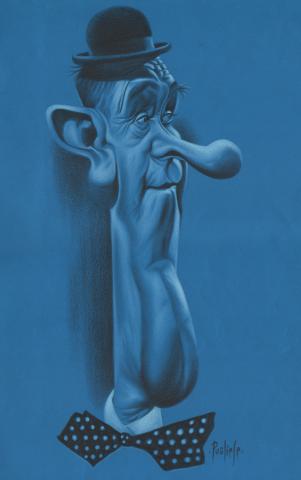
El Flaco - Pugliese
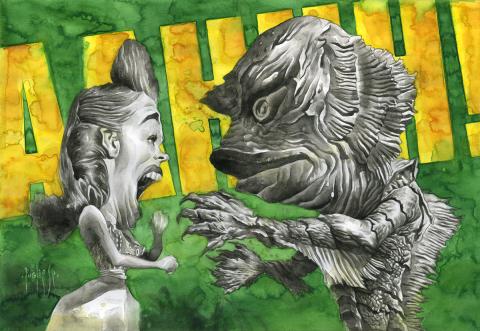
The Creature of the Black Lagoon - Pugliese.
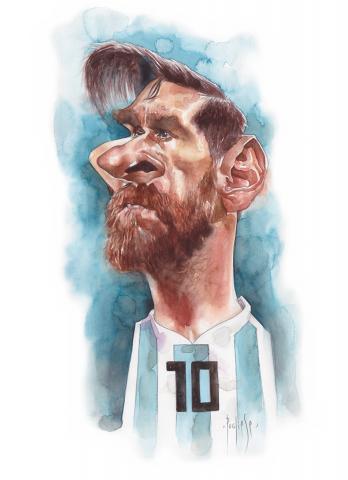
Messi - Pugliese
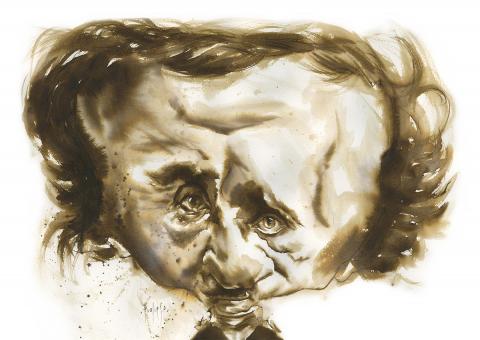
Edgar Allan Poe - Pugliese
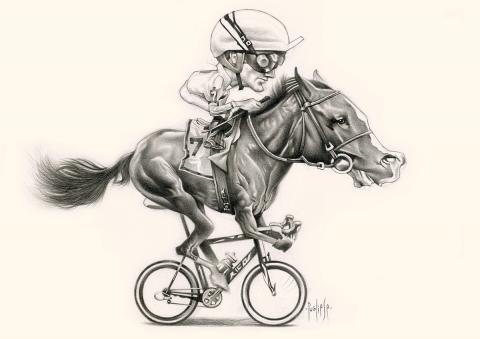
Bikerhorse - Pugliese
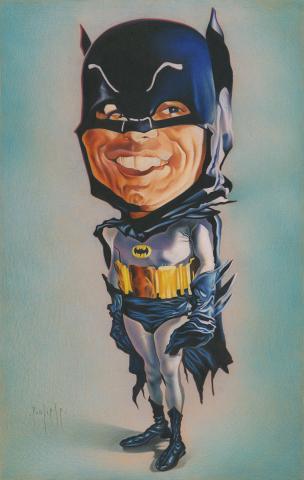
Batman 1966 - Pugliese
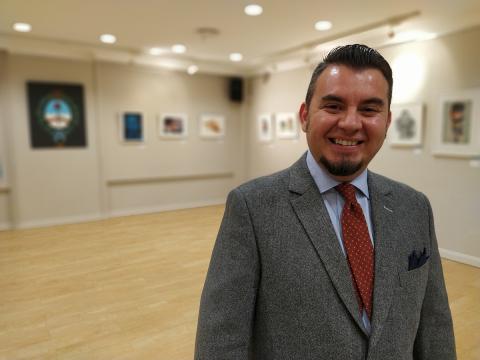
David P. Pugliese
Interview with David P. Pugliese
By Pepe Pelayo
Caricature is a discipline in itself that occupies a privileged place in the History of Art.
Today's guest to "discuss with me" is someone with a fruitful and successful career. This is David Pablo Pugliese, Argentine cartoonist, based in Spain.
He collaborates with his works in countless international publications, his caricatures have been exhibited in many countries. He has published books and has received awards and distinctions at the XX Biennial of San Antonio de los Baños, Cuba; at the First International Festival of Graphic Humor of the River Plate Atlético Club; at the international caricature festival "Humour a Gallarate", Italy, at the "Pernambuco International Graphic Humor Show", Brazil; in the international graphic humor contest "Noticartún", Colombia and in the World Press Cartoon, Portugal.
But let's move on to the “dialogue”…
PP: My friend, I welcome you, thanking you for your generosity in agreeing to share a time with me. You know that I greatly admire your work (the Stan Laurel cartoon is the one I like the most, I confess). It is time that we
Let's have a coffee or a glass of wine face to face, right?
PUGLIESE: Yes, of course, I would love to. Let's see when you come to visit me in Barcelona.
PP: Well, it might surprise you, because my son lives in Vigo and I go to Spain all the time. Well, before starting with my questions about you, about your work and about humor, I would like you to introduce yourself, in case there are any followers of Humor Sapiens who do not know you, because I got the impression that I did not introduce you as well enough.
PUGLIESE: I am an Argentine cartoonist. With everything that implies. Sometimes I work as an illustrator and I am also a drawing and illustration teacher.
PP: And modest, without a doubt. You have specialized in personal caricature. Have you ventured into another modality within humor?
PUGLIESE: When I started drawing I tried to make jokes, graphic humor. But they don't come out. I only came up with two. Then I participated in work projects with experienced comedians such as Victor Wolf, Claudio Kappel, Santiago Cornejo or Sergio Más, illustrating their ideas and scripts. I also did a scriptwriting workshop with the great Maicas. And here in Europe I have comedian friends like Napi, elchicotriste or Kap himself. But graphic humor is not my thing, my inclination is absolutely visual.
PP: To better calibrate the previous question: do you consider that personal caricature is within the universe of humor or not?
PUGLIESE: Yes, it is within the universe of humor, its origins and its own name indicate this. But I think it doesn't have humor as its main ingredient. The important thing in the caricature is to find the essence of the character. It needs to be a good interpretation. I think that in caricature satire is a more important component than humor. On the other hand, caricature is a discipline in itself that occupies a privileged place in the History of Art. That is why in the best caricatures the essence of the drawing and also that of the cartoonist is present.
PP: It's up for debate, my friend. Because I consider satire to be humor. Humor is an umbrella that encompasses satire, as I say, but also irony, parody, caricature (personal or not), jokes, etc. Therefore, for me caricature in general belongs to graphic humor. But anyway, no one has the absolute truth and the great thing is to motivate yourself to theorize about the subject, right? Well, how did you get into the cartoon?
PUGLIESE: When I started studying drawing what I liked most was comics, superhero comics. But then I began to be interested in illustration and discovered caricature because "coincidentally" the cartoonists who
I liked them the most, they used caricature resources in their work, even if they did not draw a famous character. That reminded me of the cartoons I saw in my childhood in “Humor” magazine and in the newspapers of the time. From there I immersed myself in the world of caricature and understood its importance.
PP: Great. But tell me, has your form evolved from when you started to today? Were you always so “exaggerated”, stylized?
PUGLIESE: Yes, my work is constantly evolving. Inevitably. In fact, in some aspects it has changed quite a bit. For example, at first I was interested in making realistic, detailed caricatures. And as the years and experience went by, I became interested in other more plastic aspects such as composition, stains or textures. Nowadays I am more interested in suggesting than showing.
PP: Perfect. I like that a lot. And to continue in this line, how do you choose your models to caricature? What is the process like to capture their soul and bring them to a plane with whatever technique?
PUGLIESE: If I make a cartoon that is not a commission, I generally choose a character that inspires me and awakens some emotion in me; whether it be affection, admiration, or anger. The process would be more or less this: first I choose the photo, looking for it to have certain interesting plastic qualities, such as lighting or color. Then I make very spontaneous, quick and synthetic sketches in direct ink, trying to find the gesture and attitude of the character. And when I arrive at a sketch that convinces me, I start making a more detailed drawing. Then I paint it.
PP: By the way, how do you use color? Why are some cartoons in black and white and others in color? How do you decide that?
PUGLIESE: Black and white can be very expressive, even more than color. Generally I choose the character I want to draw, but sometimes without intending it I find a photo that catches my attention and gives me
I want to draw it immediately. If that photo is in black and white, I prefer to paint it that way. In addition, there are many characters of my interest who are from past centuries, when photographic procedures were more limited. As for color, first I observe the colors suggested by the image and from that I make an interpretation, which generally has a lot of improvisation.
PP: I could comment: “How interesting!”, because I really feel that way, but I won't say it because that turn is very devalued. And now to change the “wave”. Can you tell us a funny, curious or ingenious anecdote that you have experienced in your career as a cartoonist?
PUGLIESE: Having just arrived from Argentina to Barcelona, the city that I adopted as my own with my wife in 2015, I was invited to a meeting of several cartoonists and comedians with an editor, for a project to make a magazine. I was full of excitement, my first European work experiences, being part of a new magazine from the beginning. What will it be like to work with a European publisher? After a great meal at a downtown restaurant at coffee time and after having talked about ideas and successfully shared my portfolio, when it seemed that the project was about to come to fruition, the editor blurted out the following sentence: Let's see how much money it costs. the printing, how much money the distribution costs and how much money THERE IS for the cartoonists.
PP: Ha ha, what a strange way to start a project like that. But hey, at least you ate for free, ha ha. My friend, do you like to draw your caricatures more at your workplace or in public, in direct contact with your models?
PUGLIESE: They are two different experiences. I really like drawing in public, people come up and are curious. People enjoy watching drawing. I think it's a good way to make the profession respected as well. But, of course, I prefer to be in my studio, quiet, listening to music, focused on what I am passionate about, which is drawing and painting.
PP: The same thing would happen to me if I had that talent that you have. And moving on to something more unpleasant, have you had any censorship or problems for caricaturing someone?
PUGLIESE: I have been cartooning for more than 20 years and in general I have never had any problems. But a while ago I published a cartoon accompanied by a phrase said by the character himself. And the next day, someone who apparently didn't like the cartoon (or perhaps was bothered by the fact that it exposed the subject's perversion), left me a comment accusing me of horrible things. I chose not to answer him, something I learned from MASTER Hermenegildo Sábat.
PP: You did very well. Teacher, how do you see the present and future of the cartoonist?
PUGLIESE: That depends on each person. In my opinion, today the general quality of the discipline is being lost, most cartoonists do more or less the same. Almost everyone tends to copy themselves, especially those who work digitally. It seems they are looking for quick results. And this is a job that entails learning that can last a lifetime. We have to train ourselves by learning from the masters of the past. He who understands it this way will have a good future. But anyone who wants to innovate, using only technological resources, will not achieve much.
PP: Very good. And to close, can you think of any questions that I haven't asked you and that you would have liked me to ask you? If so, can you answer it now?
PUGLIESE: I would like to talk about Entusiasta Gallery, the studio that I run with my wife Jésica Cichero, who is also an illustrator, in which we articulate everything we do: drawing and illustration classes, graphic communication services, our own editorial projects and a art gallery (for now virtual) with artists
luxury guests.
PP: Perfect! I congratulate you! And finally, dear friend, can you say a few words to our Humor Sapiens followers?
PUGLIESE: Well, I would tell you that I am glad that there are people who enjoy cultural manifestations in general and in particular the careful work of research, study and dissemination of humor in all its variants that you do in Humor Sapiens.
PP: Thank you a billion for those generous words, Master. I hope you had as much fun as I did, despite the questions I asked you. Thank you
for having agreed to the interview, really. I wish you good health and may success continue to rain down on you. A hug.
PUGLIESE: Thank you very much Pepe for taking me into account and for your GOOD HUMOR. A big hug.
(This text has been translated into English by Google Translate)

